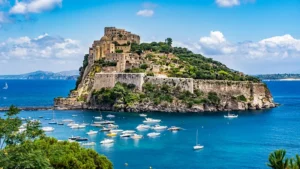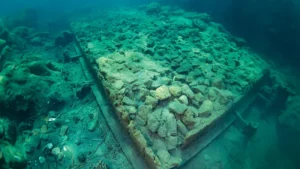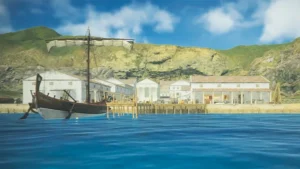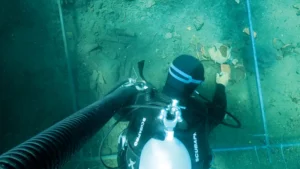
Nearly 2,000 years ago, a volcanic eruption swallowed the ancient city of Aenaria. Today, underwater tours and ongoing excavations are bringing the island of Ischia’s rich and mysterious past back into the light.
“You’re fine. Just don’t look down.”
I inhale sharply, grasp the captain’s extended hand, and step onto the boat. Only a sheet of glass separates me from the shimmering sea below.
As we cruise into the expansive Bay of Cartaromana, rugged cliffs rise dramatically from the water. Sunbathers lounge near the arched bridge leading to the 2,500-year-old Aragonese Castle, clinging to the island like the tail of a surfacing whale. After a short 10-minute journey, we reach a cluster of buoys marking the submerged ruins. I lean over the boat’s glass bottom, pressing my palms to its cool surface. Through the clear, blue-green water, past fields of swaying seagrass and darting striped fish, I spot what looks like a pile of stones. As the seagrass shifts, it reveals a neatly arranged rectangular structure, its edges framed in wooden beams. It’s an ancient quay—undisturbed and remarkably intact after centuries beneath the sea.
Ancient Rome, almost within reach.
I’m on the Italian island of Ischia, where, around AD 180, the eruption of the Cretaio volcano is believed to have sent the Roman port city of Aenaria plunging beneath the sea.
At least, that’s the leading theory among archaeologists. Unlike the well-documented eruption of Mount Vesuvius in AD 79—described in detail by Pliny the Younger before it buried Pompeii—there are no historical records of this volcanic event, and little is known about Aenaria itself.
For nearly two millennia, the city left no visible trace. Its ruins lay hidden beneath layers of volcanic debris and sediment at the bottom of the Bay of Cartaromana.
Clues to its existence first surfaced in 1972, when two scuba divers discovered Roman pottery fragments and a pair of lead ingots off Ischia’s eastern coast. The discovery sparked archaeological interest, prompting an investigation led by local priest Don Pietro Monti and archaeologist Giorgio Buchner. But despite their efforts, the search came up empty. Authorities sealed off the bay, and the mystery remained unsolved for almost 40 years.
In 2011, a group of dedicated local sailors revived the excavation efforts—this time digging directly into the seabed. Their persistence paid off: just two meters beneath the volcanic floor of the bay, they uncovered the remains of a vast Roman-era quay. Continued excavations revealed even more—coins, amphorae, intricate mosaics, remnants of seaside villas, and the wooden skeleton of an ancient ship.
For centuries, Aenaria hovered between legend and history. Now, its rediscovery is rewriting Ischia’s past and giving visitors a rare opportunity each summer to explore a long-lost chapter of antiquity once believed to be swallowed by the sea.
A Mysterious History
For generations, Ischia was known primarily for its Greek heritage. The island gained fame as the location of the first Greek colony on the Italian peninsula, founded around 750 BC on its northern coast. The Greeks named it Pithecusae and took advantage of the island’s volcanic thermal springs to establish some of the earliest known spas.
Today, Ischia is celebrated for its lush scenery, relaxed atmosphere, and thriving thermal spa culture—making it the epitome of an Italian wellness retreat. Yet beneath its beauty lies the powerful Campi Flegrei supervolcano. It’s this very volcanic activity that has sculpted the island’s rich greenery and rugged, untamed coastline.
That same volcanic activity is also what archaeologists long believed had deterred the Romans from establishing a lasting presence on Ischia.
When the Romans took control of Pithecusae around 322 BC, they renamed it Aenaria—a name that appears in ancient writings by figures like Pliny the Elder and Strabo, often linked to military affairs. Yet, unlike the Greeks—who left behind necropolises, kilns, and abundant pottery—the Romans seemed to leave only minimal traces: a few simple tombs, some inscriptions, and scattered fragments of opus reticulatum. This led scholars to conclude that while the Romans had visited or used the island, they never truly settled it—likely driven away by its persistent volcanic unrest.
“The name was recorded,” says local resident Giulio Lauro, “but no one could ever find the place.” For years, archaeologists searched for Roman Ischia on land—unaware that it had been hidden beneath the waves all along.
The Modern Rediscovery
Giulio Lauro, founder of Marina di Sant’Anna—the cultural arm of the Ischia Barche sea-tourism cooperative—has played a pivotal role in bringing Aenaria back into the spotlight. Alongside various local cultural groups made up of Ischian sailors, archaeology buffs, and history enthusiasts, Lauro has helped fund the underwater excavations for the past 15 years—all without external financial support.
He’s the first to admit he’s not a scientist. “But I love the sea,” he says. “In 2010, I had the idea to take another look… People remembered the artefacts found in the ’70s. I thought, why not give it a try?”
The original goal was to create an underwater cultural attraction, explains Dr. Alessandra Benini, the project’s lead archaeologist. “Then it became, ‘Let’s see if there really is a deeper history beneath our island.’”
Lauro remembers the hurdles vividly: “Getting permits, training volunteers, finding the money. We started from nothing. We were lucky to believe in it—and even luckier to actually find something.”
The discovery turned long-held assumptions on their head.
“It was always thought the Romans never built a city on Ischia,” says Benini. “But it turns out, the opposite is true.”
Aenaria Rises from the Sea
Each day in the Bay of Cartaromana, swimmers dive off rocky shores and sailboats sway gently in the waves. It makes you wonder—do they know what lies beneath?
“Most locals do, thanks to the archaeologists,” says local guide Marianna Polverino. “But few tourists realize Aenaria even existed—or that they can visit it.”
Every summer, Benini and her team resume excavations on the seabed. It’s a slow process, made even more difficult by limited funding. “They invest in Pompeii, in Herculaneum,” says consulting archaeologist Maria Lauro, “but here, we can only work from May to October because of rough seas.”
During the active excavation season, visitors can explore the site in a variety of ways: glass-bottomed boat rides, snorkeling, and even scuba diving excursions offer close-up views of the ruins. “You can watch underwater archaeologists in action, see the tools they use, and learn about the excavation process,” Benini explains.
All tours begin at the cooperative’s small auditorium, where a 3D video sets the stage. Artefacts recovered from the site—amphorae, oil lamps, and distinctive herringbone-patterned opus spicatum tiles (a common feature in ancient Roman shops, according to Benini)—are displayed beneath a layer of sand under glass floor panels.
The video, originally designed for children, follows a submarine journey that ends in a vivid digital reconstruction of Aenaria. I find myself captivated. The Roman quay hugs the shoreline, leading into a city of stone-paved streets and columned buildings. It’s haunting to imagine that nearly 2,000 years ago, someone—perhaps a Roman soldier—was standing on that very quay, moments before it collapsed under their feet.
Benini has her own idea of what happened that day.
“Maybe it was a tsunami-like wave or a violent earthquake that surged through and dragged everything into the sea,” she says. “That’s the movie we all picture in our minds.”

Rewriting Ancient History
Each summer, the picture of Aenaria becomes a little clearer—though questions still remain about the true nature of this ancient site.
Was it actually a city? Dr. Alessandra Benini clarifies: “The name Aenaria referred to the entire island. So it’s not that we haven’t discovered the Aenaria mentioned in ancient texts—Aenaria is Ischia. That much is certain. What we’ve uncovered is a Roman-era settlement with a port that was clearly integrated into Mediterranean trade routes, and likely had a nearby inhabited area.”
Radiocarbon analysis of wooden stakes from the quay dates the structure to around 75 BC to AD 30. In 2020, the discovery of a sunken ship added more depth to the story, revealing naval artifacts like a bronze mooring post shaped like a swan’s head—typical of Roman military ships—and lead sling bullets, suggesting that Aenaria may have served as a key military outpost overseeing the Gulf of Naples.
The amphorae recovered from the site offer further evidence of the port’s vast trade network. A total of 142 clay vessels were traced back to 12 different production regions, spanning from Campania to the Levant. Recent analyses even identified Spanish origins for some of the lead found at the site, reinforcing the settlement’s extensive Mediterranean connections.
“It’s very likely that a small town stood near the port,” says Benini. “We’ve uncovered thousands of mosaic tiles, roof tiles, wooden combs, net-mending needles, and fragments of decorated plaster. These aren’t just indicators of commerce—they suggest daily life, a residential presence.”
Since the early excavations began, two seaside villas have also been revealed, featuring elegant arched galleries, alcoves, and remnants of Roman-style baths.
“The ruins of Aenaria offer a window into the lives of the ancient people who once inhabited this island,” says tour guide Marianna Polverino. “It was clearly a major hub of trade in the Mediterranean. You begin to see just how vital Ischia was—and continues to be—while always keeping in mind the rich history hidden beneath its surface.”

Looking Ahead
I ask Dr. Benini what she hopes to uncover in the coming summer season.
“My dream is to find the foundations of the residential city,” she says. “If we’ve located the port, then it’s certain a city must have existed nearby.”
The team aims to incorporate advanced technologies like Lidar, Georadar, and sub-bottom profilers into their excavations. But as Benini notes, “That kind of equipment is costly. We need more investors to make it happen.”
Beyond funding, the team’s greatest challenge remains raising public awareness. “We’re revealing a chapter of Ischia’s history that had been lost until now,” Benini explains.
“Almost everything we’ve discovered—about 99% of it—is underwater. It’s just like Pompeii. Until it was unearthed in the 1700s, people had no idea it existed. But that doesn’t make it any less real or significant.”
“We’ve rewritten history,” says Lauro. “Everyone gave up on the idea that anything remained in the bay. But we didn’t—and we found it.”
